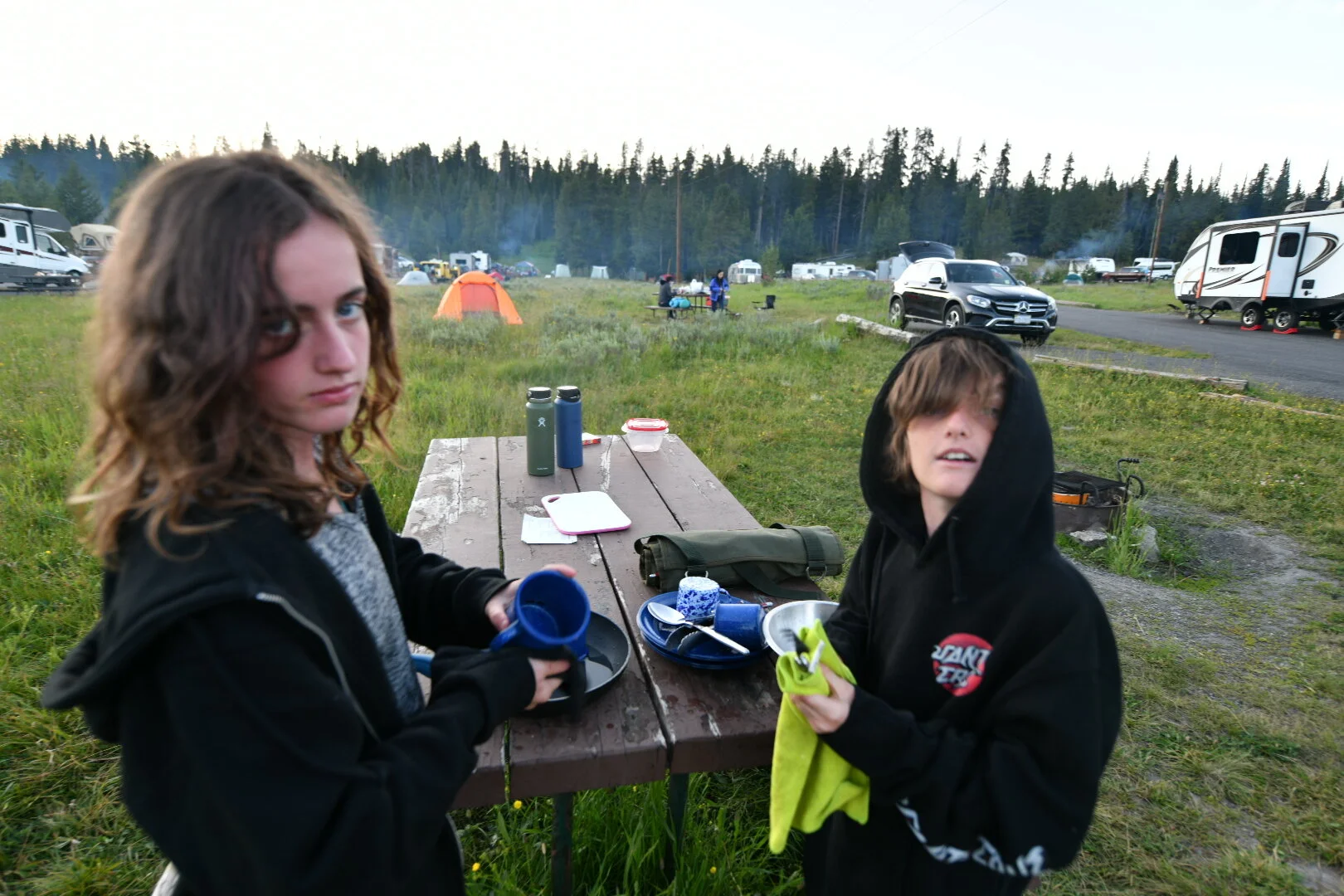Watching geysers in Yellowstone
Old Faithful
Yellowstone/Bay Bridge Campground
25 – 27 July
Elevation: 7,800 f/2,377m
Mild and cloudy; cold at night
We stayed in the Bridge Bay campground on Yosemite Lake. This campground has 420 sites, making it more like a small village than a campsite. There were all kinds, from the rolling thunder of mobile home behemoths to simple Coleman tents. There was a pleasant Japanese couple next to us who had a bright white tent that glowed orange at night. There was a newly married couple, in their sixties, who were camping for the first time. There were the big families from the Midwest who seemed to set up camp and then sit around and drink all day. There were bikers on massive Harleys who became radical gourmands over their grills. There was a Latino family that played catch well into the dark. There was a long black cylindrical tent from which emerged a mixed-race family. It was, finally, a fair crosscut of America, with everyone literally and figuratively pitching tent in this massive campground in the equally massive Yellowstone National Park.
Kids at camp.
Maybe, just maybe, these gems of the country, the National Parks, had captured something that use to exist in baseball stadiums and bowling alleys? This refers to Robert Putnam’s academic work that describes how the weave of America changed with the rising dominance of capitalism. His argument goes that the rich and poor, the foreman and the worker, use to crowd together at baseball parks and played together, one and all, in bowling leagues. Now, there are sky boxes for the rich and bowling leagues have sunk well below the lowest brow. As this argument is from the eighties, it wreaks of simpler times. Todd Gitlan, who sparred with Putnam, countered with the power of the media, claiming that the television show All in the Family did as much for class and race relations as the civil rights movement. That was quite a way to make his academic name.
Contemporary times are seemingly so much more complex, well out of the reach of the academic’s backward glance. Capitalism? What does that mean in the instant gratification, Kardashian-esque buying frenzy in which Americans engage? The media? What is it? And before you answer that question know that it has splintered and mixed into something different by the time you’ve finished this sentence. The one thing that we know is that many of us are experiencing a sinking feeling of dread. There just seems to be so much despair and misery, even before Covid. Trump’s racist and authoritarian tirades. The looming existential threat of climate change. The quick erosion of civil rights. It all seems so bleak.
Yet, the Sixties were surely worse, with Vietnam and Equal Rights mixing together in a drug fueled lunacy? Or World War II? The First World War? How does this American era sit in history? Hard to say. Paul Kennedy published The Rise and Fall of Empires in 1987, a not so subtle proclamation that the American empire was sinking fast. What if Trump refuses to leave office and his ignorant and angry minions take to the streets? They already seem to be doing so in their hyped-up response to BLM. Silvia asked if California could or would secede and I told her about how Governor Jerry Brown had plans drawn up for just that in the late Seventies. All of these ideas that seem old are actually, in historical terms, quite fresh and relevant. America is in a steady decline. The media and society have morphed into endless spectrums of isolated units that eye each other with ever more envy, suspicion, and, inevitably, hatred. The feeling of dread is real and justified.
Elk at camp.
Yet, here we are, pitching our own little tents amongst this random selection of America, all there to be outdoors, to watch the elk and bison as they meander through the site, to eat outside, and to master the labor of all this outdoor enterprise. People say hello and chat, most with masks and with an awkward distance between them. No friends were being made in this time of Covid but we were reaching out, trying to say that in this vast wilderness, we still have a place that we share together. On this great and awesome wilderness, maybe we all could agree.
Yellowstone is best known for its geysers, and Smoky the Bear, of course. Smoky the Bear was still on a lot of the signs and he made me smile every time. The geysers are strange. Putrid eruptions from deep within the earth, staining the surface yellow, red, and gray. I made the unfortunate joke of this being a case of Mother nature’s diarrhea—the kids latched onto this much to Silvia’s chagrin. The most famous geyser is Old Faithful that shoots up a good 100 feet every 90 minutes or so. It is surrounded by parking lots. We all come in our menagerie of trucks and campers, busses and jeeps, and then huddle together in a semi-circle around the geyser, waiting for it to pop. Many people wear masks. Most do not. Everyone is dressed down, with t-shirts emblazoned as much with BLM and Eracism as American flags and bald eagles. We sit around the geyser’s sulfurous bump, waiting, and when it starts to blow everyone ooohs or aahs and then we watch as it shoots up into the blue sky. When it drops back down, we all clap and hoot, thousands of us, cheering at this remarkable natural spectacle. Afterwards, we all walk back to our vehicles and go along our way.
Waiting for Old Faithful



